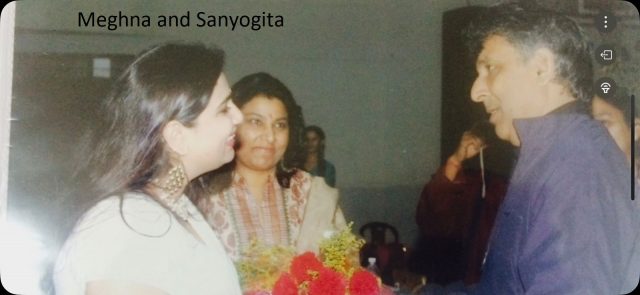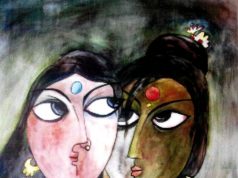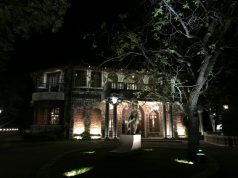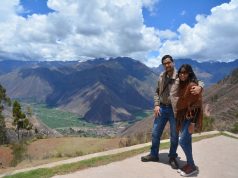 By Kulbhushan Kain
By Kulbhushan Kain
Every so often, life presents us with coincidences so extraordinary that they feel like passages lifted from a novel rather than episodes from one’s own life. Recently, I had one such experience—triggered by nothing more than an old photograph that came back into my life after nearly twenty-five years.
The photograph was taken at a function long ago in which I am seen presenting bouquets to two young ladies – Meghna and Sanyogita Singh. Meghna and Sanyogita are the granddaughters of one of India’s most celebrated soldiers – the late Lt General Sagat Singh. The occasion was an inter school debate competition held in Delhi Public School, which had just been founded in Jaipur. We wanted to get Lt General Sagat Singh to grace the occasion – but realised that he was too big a name and too busy to be able to come. We did not dare to approach him!
Lt General Sagat Singh was a legendary military general whose name has been etched in the annals of Indian history. His name is synonymous with liberation of Goa from the Portuguese, defending the Nathu La Pass against an aggressive Chinese attempt, quelling of an internal rebellion in Mizoram, and most famously crossing the river Meghna (India’s first heliborne operation) to take over Dhaka, which led to the creation of Bangladesh. In fact, Meghna his granddaughter, (daughter of his eldest son Colonel Ranvijay Singh), was named after the operation. His farmhouse in Jaipur is also named “Meghna”. Our sports teacher had initially suggested the name of Irfan Khan, then a fledgling and rising star who was just beginning to create waves in Bollywood. We decided to call Meghna and Sanyogita – because of their lineage. We never regretted our choice. Meghna later became a topflight corporate lawyer, and Sanyogita was to earn fame as perhaps India’s first woman Polo commentator. They lived with their grandparents in a sprawling house (Lt General Sagat Singh and his wife Kamla Kumari) along with nearly a dozen dogs, cats, geese and rabbits! One dog in particular, a Saint Bernard named Babushka, was a celebrity. People often went to see him – among them being my son Pratique!
At that time, the gesture (of gifting tree samplings to Meghna and Sanyogita) felt warm but ordinary. I didn’t attach much significance beyond the event itself. But as time would prove, the photograph was a quiet keeper of a story that was yet to unfold. There is a curious cruelty with photographs: they freeze a moment while letting its story remain mutable. For decades, the ladies in that picture existed as fragments in passing conversation, in a far recess of an aging memory – a name here, a half-remembered anecdote there. Only slowly, pieced together through a chance WhatsApp message with a teacher friend of mine from Jaipur days, was I to realise how central the photograph is to the architecture of my life. The ladies with thoughtful eyes and easy smiles turned out to be old friends of the teacher who was responsible for getting them to the event as judges. The man talking to them is me who looks like someone in mid-laugh and asking a question. It was a moment that had frozen in time. It remained like that till… I moved to my hometown, Dehradun, after nearly three decades, looking to finally settle down. I had made up my mind to sell off my ancestral house in Clement Town, which was no longer the place it once was. I looked for an alternative, where I could put down new roots. Like so many others, I navigated real estate agents, deeds of sale, helpful friends and lawyers, until I finally bought a property from someone I had never heard of, or met before. He was different –polished, well-bred and an alumnus of The Doon School. But to me, it was largely a transaction—the formal start of a new chapter. The happiness of buying a beautiful property with lots of trees was outweighed by the selling of a property which had my childhood in every brick and tree of it.
It was only later, through a chance conversation, I discovered that the gentleman I had purchased the property from was the son of the late Brigadier Amarpal Singh and his wife Premada. But who were Amarpal Singh and Premada and how do they fit into this article about Lt General Sagat Singh?
Amarpal Singh was the brother of Kamla Kumari, wife of Lt General Sagat Singh. Thus, Sagat Singh was Amarpal’s “Jijosa” (as they call the brother-in- laws in Rajasthan). Amarpal Singh and Kusum Kumari’s dad, Rachpal Singh, was a retired Chief Justice of the Jammu and Kashmir High Court during the years 1940-1942. The family lived on Laxmi Road, just a stone’s throw away from my property. I bought a part of the property from the son of Premada and Amarpal Singh, both of whom had expired many years ago.
Suddenly, the photograph came alive with a resonance I could never have imagined. What had once been a frozen moment in time was now revealed to be a subtle thread weaving together distant points of my past to the present in my life.
This coincidence reaffirmed for me the extraordinary power of photographs. At first glance, they are simple keepsakes—paper, ink, pixels. But in truth, they are time machines, capable of collapsing decades into a single heartbeat. They connect the past with the present, reminding us that our lives are not a series of disconnected events but rather a tapestry, with hidden patterns that only become visible with time. Little did I know that the granddad of the ladies with whom I shared a few moments and of whom so many Indians are still in awe, must have walked in and out of the premises that are partly mine now!
They also contain the magic of nostalgia. Looking at that photograph, I was not merely reminded of a ceremony or a smile frozen in time. I was reminded that life often has a way of circling back, bringing us face-to-face with people, places, and legacies we once thought we had left behind.
For me, who is a compulsive photograph preserver, and a history buff, the photograph became more than just a memory—it became a revelation. It told me that coincidences are life’s gentle reminders that we are part of a larger story, one in which even the most ordinary encounters can carry meanings that will reveal themselves years later.
That is why I hold on to old photographs. They are not just souvenirs of the past. They are keys to mysteries yet to be unlocked, and proof that life, in its quiet wisdom, always has one more surprise waiting for us
Cesare Pavese had said, “We do not remember days. We remember moments.”
Photographs help us do that.
(Kulbhushan Kain is an award winning educationist with more than 4 decades of working in schools in India and abroad. He is a prolific writer who loves cricket, travelling and cooking. He can be reached at kulbhushan.kain@gmail.com)







